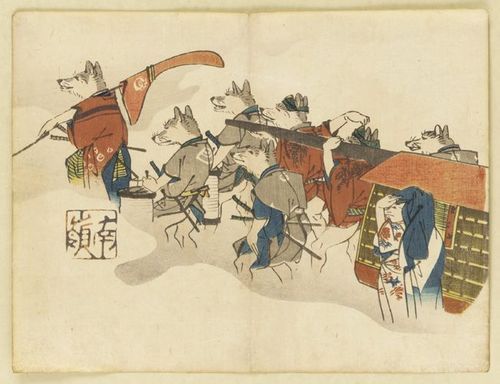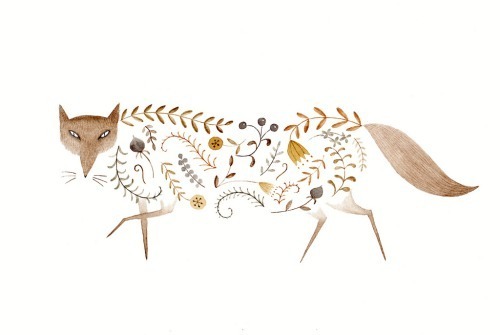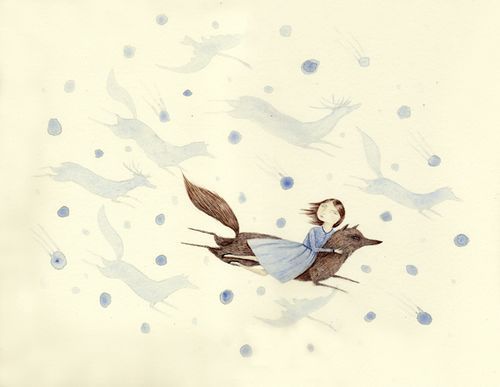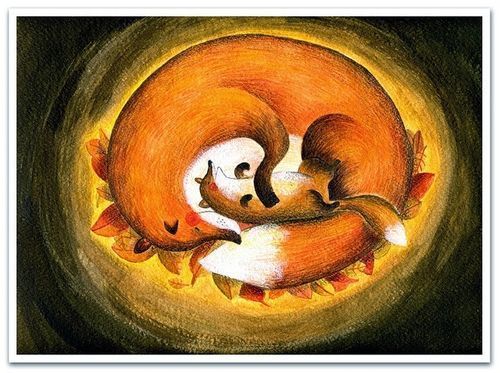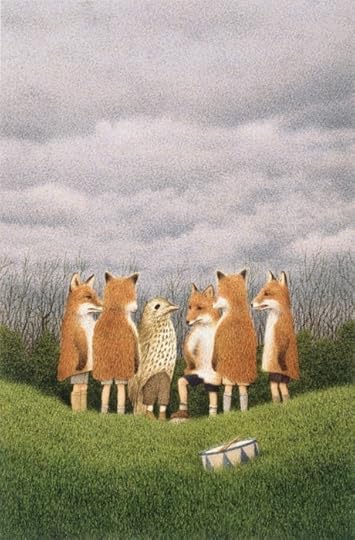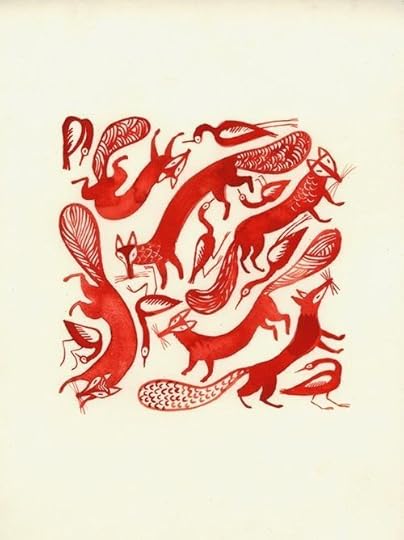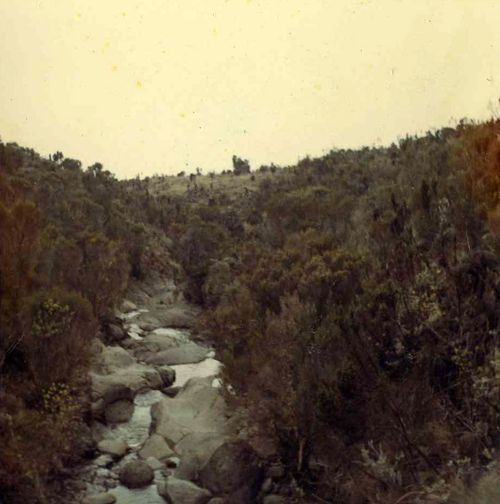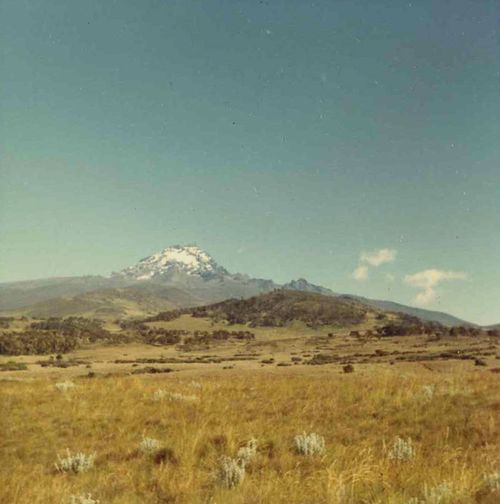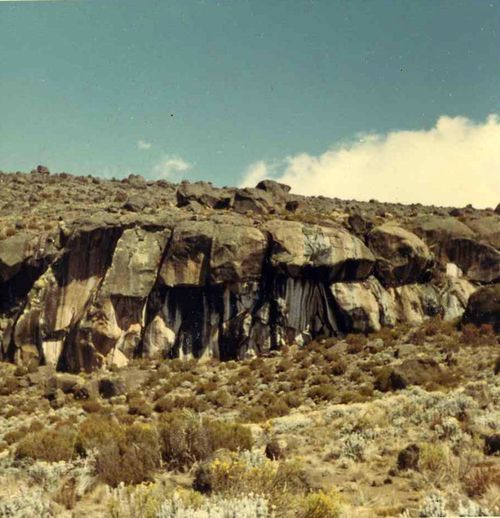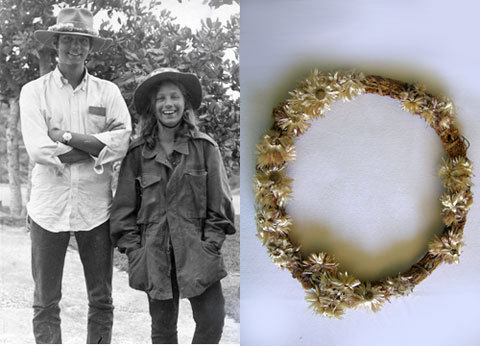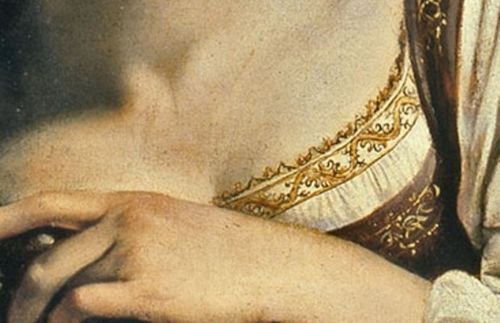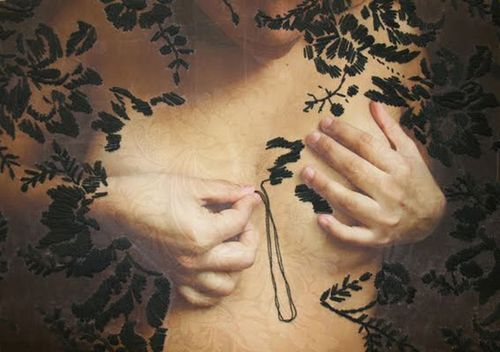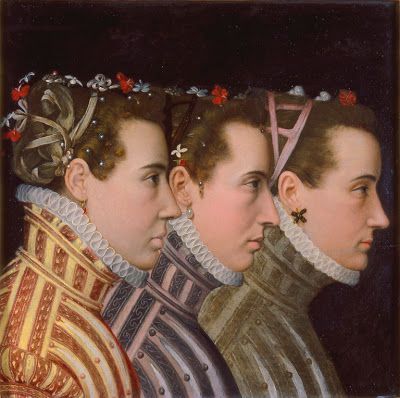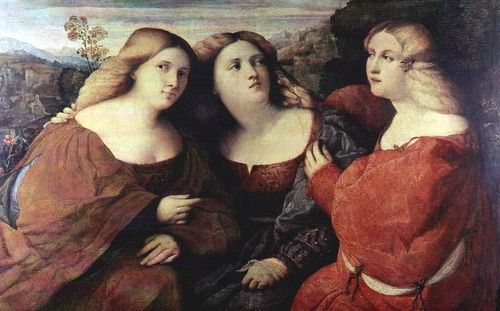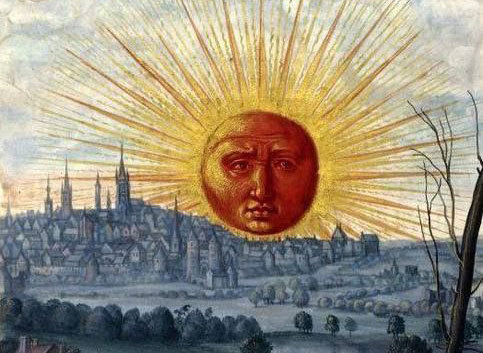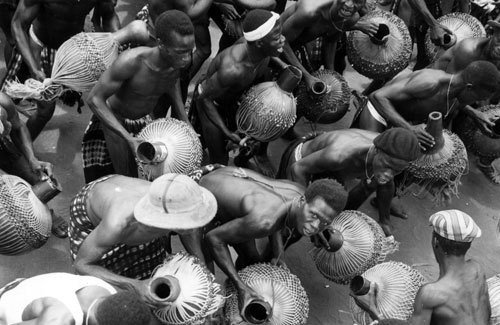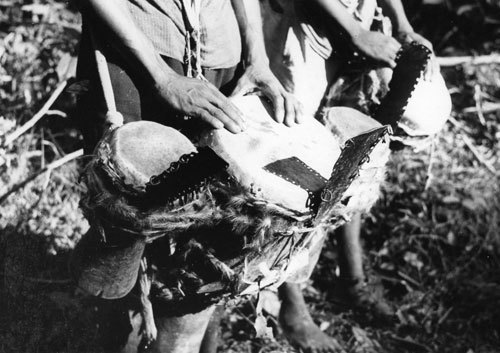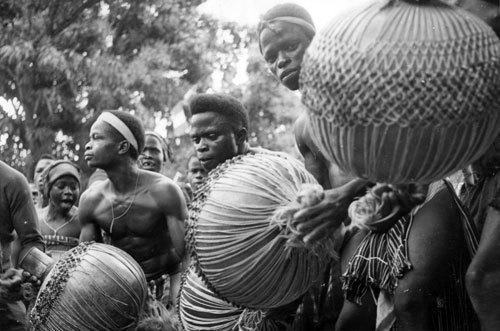Midori Snyder's Blog, page 44
October 28, 2014
"And I Rose in a Rainy Autumn"
Happy 100th birthday to the great Welsh poet, Dylan Thomas.
"My birthday began with the water--
Birds and the birds of the winged trees crying my name
Above the farms and the white horses
And I rose
in rainy autumn
And walked abroad in a shower of all my days...
Read the entire poem "Poem in October" (1945) here. Or better yet, listen to Dylan Thomas read it...
October 27, 2014
A Skulk of Foxes
It's been one of those months...distracting and demanding. So I am here now, trying to make up for all my lost time. I have a lot to say about these days...but am still wading through the need to get more done here and there. So here...a collection from my pinterest account of gorgeous foxes -- lovely illustrations that have captured my imagination and added a new collective noun "skulk" to my vocabulary.
Credits top to bottom: New Yorker Book Week 1950, "The Foxes Wedding" by Suzuki Nanrei, ""Twig Fox" by Julianna Swaney, "The Fleet" by Lauren Careny, "Night Migration" by Juliana Swaney, "Tana" by Violetta Testacalda, "Woe Unto Him Who Steps Out of Line" by Quinton Buchholz," Red Foxes" by Marpez.
October 3, 2014
Looking Back on Kilimanjaro
Just today I received a facebook message from an old friend, Mary who was living in Tanzania at the same time I was 13-14 years old -- and she recalled when we climbed Mt. Kilimanjaro in 1967. At 13 years old, I was the youngest by far of the troop, which was composed of students from the Economics department, my father (who was teaching Contemporary African Literature), and Mary and her younger brother. My father made it to the first hut, at about 8,000ft. and decided that he would wait for me. I continued with the group, but when we reached what was to be the final ascent to the summit, everyone in my party -- except me--was too sick from the altitude (one travels from 2,000ft to 16,000ft in three days). Due to my age, the guide did not want to take me alone -- so close, but no go. I returned with everyone else, very disappointed.
Then a year later in 1968, I had a second chance. Everyone was young and eager for this trip -- including my brother Gil, the Hill sisters, Pru and Deb (who climbed in waterproofed hightops), Mary and her older brother Andre, and the Martin brothers. This time was more successful and five us made it to the snowy and icey summit at 19,300 ft. So this time -- in honor of that trip -- I dug back to the small collection of photos I have -- most of them taken with a tiny disposible camera!
Leaving from the hotel, we hiked for about 6 hours, through farmland, a three mile band of rainforest that was wet and misty, like being in cold, green clouds, and then rocky hills of running streams and short, scrubby trees -- until at last, we popped out above the clouds here at arrived at Mandara Hut: the first campsite at 8,990ft.
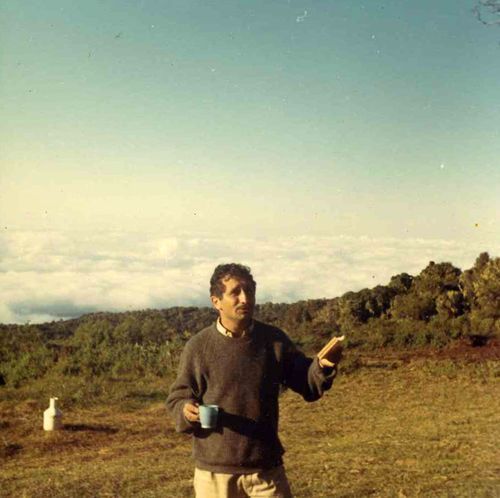 My father Emile, enjoying the rest and the camp as the clouds rolled in below. He was happy enough with having accomplished this much of the trip. I wonder now, if he was hoping that I would back out as he did have to hang out here for two more days while I wandered up to the last hut on the first trip.
My father Emile, enjoying the rest and the camp as the clouds rolled in below. He was happy enough with having accomplished this much of the trip. I wonder now, if he was hoping that I would back out as he did have to hang out here for two more days while I wandered up to the last hut on the first trip.
Leaving Mandara Hut, the sky got wider, bluer, and free of clouds as the path opened up into a beautiful alpine stretch. As we continued to climb, the alpine fields gave way to steep rocky terrain, much drier, the path now innudated with big tussocks of long grass, low clinging plants, and huge bluffs in amazing zebra stripes. We also got our first views of Mawenzi Peak -- a tough, craggy peak at the base of Kilimanjaro's volcanic plain, and the snow covered top of Kilimanjaro, high above. We arrived in the late afternoon -- footsore and starving at the second campsite, Horombo Hut at 12,400 ft.
Kilimanjaro Snow Capped Peak.
The third day of climbing took us through a vast high altitude desert -- without water, with much of anything except sparse rocks and a couple graves. Known as the "The Saddle" this flat, barren stretch was deceptive. From a far, we could see our destination Kibo Hut at 15,500 ft, and it seemed close enough. But we walked for hours, over the soft, sandy soil and it never seemed to get closer. By the time it was really in front of us, we were exhausted, and for some, their ears were ringing from the altitude and suffering headaches and nausea as well.
 Mt. Kilimanjaro, The Saddle. 1968
Mt. Kilimanjaro, The Saddle. 1968
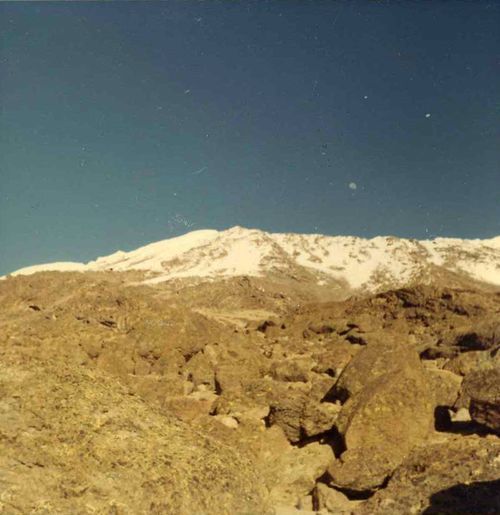 The trail to Kibo Hut, Mt. Kilimanjaro, 1968
The trail to Kibo Hut, Mt. Kilimanjaro, 1968
One doesn't sleep long at the last hut. For some it is impossible. I will confess that I loved it. I felt giddy (probably the lack of oxygen) and extremely happy. We are awakened at 12:30AM -- and by moonlight, we made the final ascent -- up through, and then snow and ice for the next five-six hours. It was pretty horrible -- one could see a bit of the ledge above you, which beckoned like the end of the trail, until you got to it, and discovered another ledge above it. My brother was sick as a dog, throwing up the last mile up to the summit -- but he refused to turn back. I am glad because it was really the most memorable thing we ever did together...epic really.
The summit is 19,000 ft and there we signed our names in a book of other intrepid climbers who had made it up. We were there at sun rise, which was pretty breath taking as the moon was also still high in the early dawn. Below us was stretched East Africa on one side where we were sitting, while the other sde gave us a view of the mouth of the volcano, filled with ice, snow, and stone. The journey back to base camp took two days -- from the summit we barreled down the trail to 12,000ft, slept like stones and ate. The next morning, we continued down to the hotel where we began our trip at 2,000ft. There, they presented us with wreaths of everlasting flowers for having successfully reached the summit. I still have mine too.
Mary reminded me that we returned by a city bus over 500 miles of rough corrugated roads, packed with people, chickens, babies, parcels of all sizes and us. It took all night, and where we sat at the back, a window stuck open, the red dust from the road covering us completely. We arrived home in Dar es Salaam a mess: my feet were a wreck of blisters, my face sunburned, and grime on top of grime from not having changed my clothes for five days. But yeah...I was really, really happy. (That's me in the blue parka, and my brother sitting below me. And beneath that photo are Gil and I on the morning of our arrival back in Dar. )
September 27, 2014
New E-Book Editions of Ellen Datlow & Terri Windling Fairy Tale Anthology Series
Super excited to see the new e-book editions of Terri Windling and Ellen Datlows five terrific Fairy Tale Anthologies -- in which I am pleased to say two of my stories appear: "Tattercoats," in Black Thorn, White Rose, 1994 and "The Reverend's Wife" in Black Swan, White Raven, 1997. These are wonderful, grown-up, not-for-children reinterpretations (some dark, some not so -- like mine) of well-known fairy tales with a strong erotic twist. That was part of the fun of writing them.
Art: "Nude in Doorway," by Silvius Krecu (1959)
September 26, 2014
Zizola in the Details
 I wrote below about keeping images of Three Sisters as inspiration for one novel, but I also keep images for the heroine Zizola (whose name means in Italian "A trifle" or a "bagatelle") for a second novel I am also researching and writing. In many ways finding Zizola has been harder.
I wrote below about keeping images of Three Sisters as inspiration for one novel, but I also keep images for the heroine Zizola (whose name means in Italian "A trifle" or a "bagatelle") for a second novel I am also researching and writing. In many ways finding Zizola has been harder.
Zizola is a 16th century Italian street child, grown into a young woman trickster with fantastic gifts of her own. She is prickly, can be sharp-tongued, no stranger to creative vulgarity, and yet hungers for what she imagines might be a "normal" life, one that can connect her to people other than her constant servant-companion Giano, a savvy Arlecchino whose appetite for food and sex constantly undermines his usefulness as a servant.
 Zizola is more of a cipher as I wrote first about her as grimey adolescent in The Innamorati, and must now deal with her five or so years older. So art comes to me as suggestion of what is under her surface. Lines, hasty sketches, someone in the process of change.
Zizola is more of a cipher as I wrote first about her as grimey adolescent in The Innamorati, and must now deal with her five or so years older. So art comes to me as suggestion of what is under her surface. Lines, hasty sketches, someone in the process of change.
But for all her sharp edges, she is also a potentially beautiful woman -- not because of perfect features, but because of the slow ripening of sensuality, of a bit more maturity that tempers her outbursts, and of her curiosity coupled with intelligence.
She's not really a beastly bride, but she shares with them an independent spirit and the power to manage her own affairs. She could be a fantastic bride, eventually offering all her gifts in the service of a creative union in marriage. The fact that she is not sure what she is and that I won't know either until she is done telling her story means that I expect the art will change considerably as she and I go forward. But here she is for now -- someone I can sense in small details, waiting for the full picture to emerge.
Art: My Agnes, Albrecht Dürer 1494, Sketch of Girl, Raffaello Sanzio 1483-1520, Detail of Lace (Artist unknown), Ana Teresa Barboza, John Singleton Copley: Mrs. Daniel Sargent (Detail)
Inspiration in Threes
I have been working on two major projects simultaneously -- a novel about Zizola, one of the heroines of The Innamorati, which will be something of a sequel, and Three Sisters -- a loosely attached third novel in the series based on an Italian folktale "Three Princesses Wed To Passers-Bye." As I work, I collect images that speak to me in some way -- evocative and sometimes provocative about the characters of the novels. I have a pinterest board where I keep most of the images for these two novels and here are some that I especially like of Three Sister-ness keeping them on my desk top so they are the first thing I see when I boot up the computer. I like the way the sisters are arranged -- close in body and in age -- the tension of being of the same root, and yet trying to be distinct. It makes for an interesting story.
Art/Photos: Lucas de Heere, 'Triple Profile Portrait', ca. 1570, Palma Vecchio,"The Three Sisters", c. 1520, The Levy Sisters, a vaudeville team. Photographer,Newsboy, 1890, Vintage photograph 1905.
September 22, 2014
Bingeing on Magicians: Lev Grossman
I waited until the third novel of Lev Grossman's Magician Series was completed, then purchased all three and read them over five days. I know, right? But sometimes that is the best way to totally immerse oneself in a big, complicated, wonderful story. To live with the sound of the voice, the rawness of characters emotions and tribulations, and keep together all those story threads and marvel at how deftly they were woven into a whole. I am leery of reviewing too much of the story because with three interconnected novels, there would be too many spoilers -- and that would be unforgivable. So what I am going to offer instead, by way of review, is a short list of everything I loved about these novels.
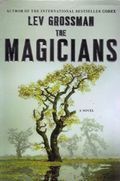 1. The Voice: Grossman's characters age from late teens, early twenties, to just touching thirty. And each novel so accurately projects the voice of their ages. The dialogue is smart, nerdy, wise-cracking, angry, and laugh out loud funny. The omniscient narrator's prose shifts with the voices, staying close to them, filling out the raw emotions of these young adults and near adults with a dense, wry, and biting writing style. The vocabulary is a perfect mixture of math, slang, geek, arcane words from dead languages, and invented words. It works so well -- it keeps the stories moving on a level that is both immediate and accessible, a clean, sharp take on an old story, that for all its wisecracking asides still manages to also be incredibly poetic and beautiful too.
1. The Voice: Grossman's characters age from late teens, early twenties, to just touching thirty. And each novel so accurately projects the voice of their ages. The dialogue is smart, nerdy, wise-cracking, angry, and laugh out loud funny. The omniscient narrator's prose shifts with the voices, staying close to them, filling out the raw emotions of these young adults and near adults with a dense, wry, and biting writing style. The vocabulary is a perfect mixture of math, slang, geek, arcane words from dead languages, and invented words. It works so well -- it keeps the stories moving on a level that is both immediate and accessible, a clean, sharp take on an old story, that for all its wisecracking asides still manages to also be incredibly poetic and beautiful too.
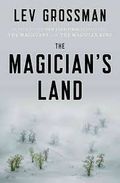 2. The Characters: Each novel offers rites of passage tales, centered around a main character, Quentin Coldwater, but supported by equally compelling characters in an ensemble effort to transform from complicated, precocious adolescents into equally complicated adults. And each novel interprets and then reinterprets the rites of passage as the characters slowly mature. Each one of them is unique and on their own path, but they collide into each other, fight with each other, love, betray, and support each other. I loved the attention Grossman gave to each one of them -- to their backstories (many of which we don't fully know until the second and third novels), the personal angst and struggle to arrive at an authentic identity. For all that it is fantasy -- the internal struggle of those characters is very real and timeless.
2. The Characters: Each novel offers rites of passage tales, centered around a main character, Quentin Coldwater, but supported by equally compelling characters in an ensemble effort to transform from complicated, precocious adolescents into equally complicated adults. And each novel interprets and then reinterprets the rites of passage as the characters slowly mature. Each one of them is unique and on their own path, but they collide into each other, fight with each other, love, betray, and support each other. I loved the attention Grossman gave to each one of them -- to their backstories (many of which we don't fully know until the second and third novels), the personal angst and struggle to arrive at an authentic identity. For all that it is fantasy -- the internal struggle of those characters is very real and timeless.
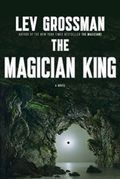 3. The Narrative Plot(s): This is a huge story, and Grossman teases it out in measured fashion, moving it along deftly, as though a shuttle through a warp and the thread then beaten into place to join the others. Separate and connected to create a rich story pattern. (I am weaving again --sorry!) It didn't matter that I knew at least thematically where the plot was going -- it was always a surprise when I got there. Grossman took wonderful chances -- running parallel story lines in the second book that occur at different times and places simultaneously, giving the reader a unique perspective of knowing both parts of a single tale before the characters do. He maintained that perfect balance between anticipation and confidence that the conclusions would be worth it.
3. The Narrative Plot(s): This is a huge story, and Grossman teases it out in measured fashion, moving it along deftly, as though a shuttle through a warp and the thread then beaten into place to join the others. Separate and connected to create a rich story pattern. (I am weaving again --sorry!) It didn't matter that I knew at least thematically where the plot was going -- it was always a surprise when I got there. Grossman took wonderful chances -- running parallel story lines in the second book that occur at different times and places simultaneously, giving the reader a unique perspective of knowing both parts of a single tale before the characters do. He maintained that perfect balance between anticipation and confidence that the conclusions would be worth it.
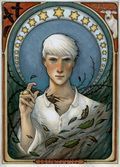 4. The Landscape and Magic: Maybe this most of all for me. I feel that when human beings from a modern world side-step into a fantastic landscape (not unlike traditional tales where one leaves for the dark wood), that the fantastic world is there to serve a metaphorical confrontation with whatever doing and undoing needs to be done to change those human beings. It is not a frozen place -- it must be in a sense a character itself, capable of parallel change, capable of morphing to keep up with the challenges set before human characters. There are quite a few fantastic landscapes in these novels, and it is fascinating how the worlds transform when humans come into contact with them. A child's eden, a darkly divided land where lurks buried dangers, a way station to other worlds surrounded by towering buildings that keep books buried behind locked doors. And time zones that will not respect the laws of nature.
4. The Landscape and Magic: Maybe this most of all for me. I feel that when human beings from a modern world side-step into a fantastic landscape (not unlike traditional tales where one leaves for the dark wood), that the fantastic world is there to serve a metaphorical confrontation with whatever doing and undoing needs to be done to change those human beings. It is not a frozen place -- it must be in a sense a character itself, capable of parallel change, capable of morphing to keep up with the challenges set before human characters. There are quite a few fantastic landscapes in these novels, and it is fascinating how the worlds transform when humans come into contact with them. A child's eden, a darkly divided land where lurks buried dangers, a way station to other worlds surrounded by towering buildings that keep books buried behind locked doors. And time zones that will not respect the laws of nature.
Magic too in Grossman's imagination is incredible rich in language and symbols from disciplines such as math, botany, alchemy, physics, chemistry, and archaic languages. It is learned in rigorous fashion in exclusive colleges, and a guerrilla version learned on the backstreets. It is inherently dangerous and addictive like a drug. It changes, depending on the individual and there are specialties, talents that are derived from some unique DNA of the magician. Like the landscape, it is never static but always evolving as the characters mature.
I really think Lev Grossman has given us a new lease on the "stepping through the wardrobe" tale of humans and magic. It is robust, effortlessly creative, and full of surprises.
Top art "Miniature of a Raising Sun, from "Splendor Solis," an alchemical treatise from 1582." Last bit of art from the gorgeous fan art from Celia Bohlin.
September 17, 2014
Putting Together My Father's Research With The Photos: West Africa 1963-64
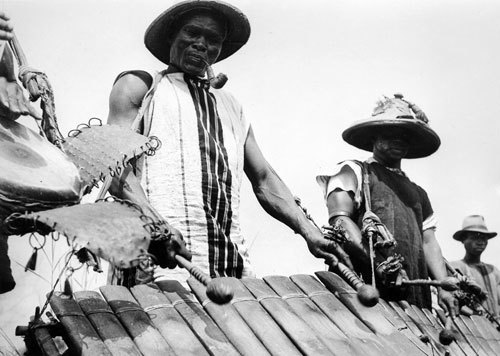 Balafon performance in the streets of Conakry, Guinea. ©1963 Emile Snyder
Balafon performance in the streets of Conakry, Guinea. ©1963 Emile Snyder
Among the amazing documents that have floated my way over the years was a manilla folder full of gorgeous black and white photographs my father took in the Ivory Coast (well..they were developed there and some of them might have been also taken in Senegal, Mali, or Guinea). Among my mother's papers that I received after her death was a carefully cached collection of letters that my parents had written to each other during fall 1963 to spring of 1964, when they were both abroad on Ford and Fulbright grants-- he to numerous countries in West Africa and she to India, Bhutan, and Sikkim.
The letters are very interesting, and cringe worthy in places. One third love letters (with some surprising revelations about their sex life I could have survived never knowing about), one third about money (there was never enough and what there was always came late allowing for some desperate nail biting) and one third talking about the research and the separate lives they were having on their different continents.
As I read through the research parts of my Dad's letters, I learned a lot about these photographs--especially that he had done many field recordings of musicians, griots, and small village brass bands. He had made friends with many African writers at the very start of their careers as authors in 1963, he had met and become friends with Leopold Senghor, President of Senegal, and other writers and poets turned diplomats -- who also gave him music tapes and recordings (especially the radio stations eager to get their music out to the West as well as Africa.). He sent 25 or so tapes back to the states with friend and ethno-musicologist Robert Garfias who returned them to the Ethnomusicology Archives of the University of Washington, Seattle, WA.
I went looking for the tapes in the archives -- as this was the first I knew that they had been properly given over to someone. I was so excited to find them listed here and here. So I will be sending scans of all the photos (plus more of the notes I discovered in his letters) to the archive there -- delighted that future students will have a chance to see these images and connect them to the music on the tapes. In many ways, the best part of finding all these papers is being able to share the really great parts of their careers with others -- to share those moments in history where they saw something, heard something, or wrote something that still matters.
All the photos can be found here -- or by clicking the link to "West African Musicians" in the left hand side bar. And all photos are ©1963 Emile Snyder -- please email me at the blog to request permission to use these photos.
September 10, 2014
Tintoretto and The Origin of the Milky Way
This is a really gorgeous painting by Jacopo Tintoretto depicting the "Origin of the Milky Way, 1575-1580." Jupiter (Zeus) seeks to give immortality to his son, Hercules, conceived during an illicit affair with a mortal woman Alcmene. He knows that only the breast milk of a goddess can accomplish such a thing and as luck would have it Juno (Hera) is lactating. Jupiter discovers Juno sleeping and attempts to latch the baby to her breast -- thinking she might not notice (really? ) When she wakes and pulls her breast away from the feeding infant, her milk sprays into the heavens and produces the stars. (Click on the image to see a larger version)
Here is a wonderful and incredibly informative little podcast about The Origin of the Milky Way from Karen Allen of the National Gallery in England exploring the wealth of creation myths alluded to in the painting (including the origin of lillies) and lovely details about Tintoretto's artistic storytelling. It's fabulous.
September 8, 2014
Flying Squirrels Still in My Life
Ok..a while ago I posted a goofy gif from the Smithsonian Library and the universe made me aware of flying squirrels every where. Here is the best -- as in total awwww cuteness article of a rescued baby flying squirrel, now named Biscuit. I do hope her rescuer Jeff Longo in time will post pictures of her accomplished flying!
Midori Snyder's Blog
- Midori Snyder's profile
- 87 followers




